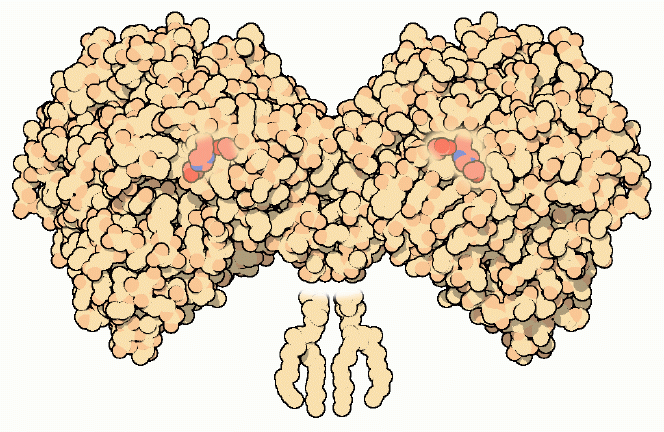|
Inhaltsübersicht | Nanomaschinen | Moleküle | Programme | Kurse | Fun | Links |
||
| > |
Acetylcholinesterase

Acetylcholinesterase
Every time you move a muscle and every time you think a thought, your nerve cells are hard at work. They are processing information: receiving signals, deciding what to do with them, and dispatching new messages off to their neighbors. Some nerve cells communicate directly with muscle cells, sending them the signal to contract. Other nerve cells are involved solely in the bureaucracy of information, spending their lives communicating only with other nerve cells. But unlike our human bureaucracies, this processing of information must be fast in order to keep up with the ever-changing demands of life.
Neurotransmitters
Nerves communicate with one another and with muscle cells by using neurotransmitters. These are small molecules that are released from the nerve cell and rapidly diffuse to neighboring cells, stimulating a response once they arrive. Many different neurotransmitters are used for different jobs: glutamate excites nerves into action; GABA inhibits the passing of information; dopamine and serotonin are involved in the subtle messages of thought and cognition. The main job of the neurotransmitter acetylcholine is to carry the signal from nerve cells to muscle cells. When a motor nerve cell gets the proper signal from the nervous system, it releases acetylcholine into its synapses with muscle cells. There, acetylcholine opens receptors on the muscle cells, triggering the process of contraction. Of course, once the message is passed, the neurotransmitter must be destroyed, otherwise later signals would get mixed up in a jumble of obsolete neurotransmitter molecules. The cleanup of old acetylcholine is the job of acetylcholinesterase.Acetylcholinesterase in Action
Acetylcholinesterase is found in the synapse between nerve cells and muscle cells. It waits patiently and springs into action soon after a signal is passed, breaking down the acetylcholine into its two component parts, acetic acid and choline. This effectively stops the signal, allowing the pieces to be recycled and rebuilt into new neurotransmitters for the next message. Acetylcholinesterase has one of the fastest reaction rates of any of our enzymes, breaking up each molecule in about 80 microseconds.Electric Fish
Acetylcholinesterase was first studied by using the form found in electric fish, such as the torpedo ray. These fish have massive arrays of nerve-like structures in the organs that generate electricity, so acetylcholinesterase is particularly abundant. The form shown here, from PDB entry 1acj, forms a dimer in the crystal structure. It normally has lipids attached to the protein chains, which anchor the enzyme to the cell membrane. The lipids were removed in the crystal structure, however, to allow crystallization. The active site is found in a deep pocket, just big enough for the acetylcholine to slip down inside. At the base of the pocket is a triad of three amino acids--serine-histidine-glutamate--that is almost identical to the triad used in the serine proteases like trypsin and chymotrypsin.Last changed by: A.Honegger,